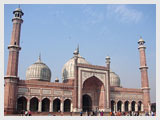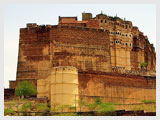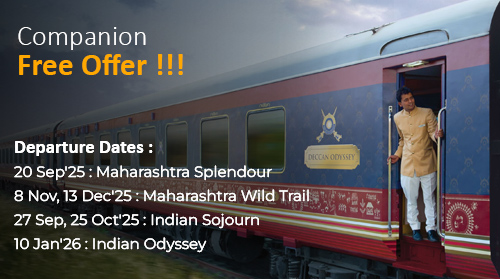
Simply Rajasthan Exploring Flamboyant India
Destination Covered: Delhi - Jaipur - Bundi - Bassi - Udaipur - Kumbhalgarh - Jodhpur - Jaisalmer - Bikaner - Mandawa - Delhi
| Tour Highlights | |
| Bundi | Sukh Niwas, Chaurasi Khambon ki Chhatri & battlefield |
| Kota | Umed Bhavan Palace & jag Mindar |
| Chittorgarh | Chittor Fort, Rana Kumbha Palace, Victory Tower, Palace of Rani Padmini, Tower of Fame & Palace of Patta & Jaimal |
| Udaipur | City Palace, Sahelion Ki Bari, Lok Kala Museum & Boat Ride at Lake Pichola |
| Ranakpur | Jain Temple Complex |
| Jodhpur | Mehrangarh Fort, Jaswant Thada & Guda Bishnoi Village |
| Jaisalmer | Jaisalmer Fort , Jain Temple, Patwon Ki Haveli & Camel Safari |
| Bikaner | Junagarh Fort & Lal Garh Palace |
| Mandawa | Havelis (Mansion) of Goenka, Gori Shankar & Choudaharia with Frescoes |
Detailed Itinerary
Day 01: Arrive Delhi
Delhi – Jaipur (262 kms – 05 hours)

Arrive by International flight, after traditional 'Swagat' (Welcome) our representative would assist you at airport & transfer to hotel for check in.
Delhi is a bustling metropolis, which successfully combines in its folds the ancient with modern. Its strategic location was the prime reasons why successive dynasties chose it as their seat of power. In fact, more mythological cities are believed to be here, like the city of Indraprastha from the Hindu epic Mahabharata, founded around 5000 BC. Numerous monuments were built over several centuries by different rulers like Qutub-ud-din Aibek, Alauddin Khilji, Tughlaks, Humayun & Shah Jahan, who built the Walled City Shah Jahanabad.
Later in first half of 20th century much of New Delhi was planned by Sir Edwin Lutyens, who laid out a grandiose central administrative area as a testament to British rule in India. The division in walled city & New Delhi also marks the division in life styles.
Later we drive to Jaipur, popularly known as Pink City, the flamboyant & colourful capital of Rajasthan. With its rich & colourful past, resplendent with tales of valour & bravery, it is now one of the most important heritage cities in India. The city was founded in the year 1728 by Maharaja Sawai Jai Singh II, the ruler of Amber. It remains the only city in the world symbolizing the nine divisions of the universe, through nine rectangular sectors.
Overnight Hotel – Jaipur (B)
Day 02 : Jaipur – Bundi (220 kms – 04 hours)

Today we drive to we visit Bundi, an undiscovered splendour of Rajasthan. Set in a narrow inclining gorge & palaces & forts have fairy tale quality about them. Isolated & independent, this picturesque location has so much to offer. Rajput architecture shines & in the intricately carved brackets, pillars. Interesting places are Diwan-e- aam, Hathia Pol, & Naubat Khana.
Half Day Tour
Today we visit the Umed Bhavan Palace, constructed during the reigns of Umed Singh on the banks of Sukh Sagar or the Jait Sagar. The palace was meant for providing the princes a free hand to do what they liked away from the supervision of the Rao. The highlight of the palace is the white marble chhatri that stands in the centre of the roof of the second storey. Next we visit the Chaurasi Khambon ki Chhatri, located south of the town & a pavilion supported by 84 pillars. The pavilion was constructed in the year 1683 by Rao Anirudh Singh to honour the services of Deva, his wet nurse. The two storeyed structure serves as a cenotaph as well as a temple though the importance of the cenotaph seems to have deteriorated with the passage of time. On the other hand the temple with Shiva Linga still commands respect from the devotees. The ceilings on both the floors are decorated with paintings of Rajput battles & fish symbols.
Overnight Hotel – Bundi
Day 03 : Bundi - Chittaurgarh via Kota (120 km – 04 hr)
Today we drive to Chittaurgarh En route we visit Kota, along the eastern bank of the Chambal River lies an amazing juxtaposition of the majestic medieval age & modern industrialisation temples its untouched wealth of impressive forts, opulent palaces & splendid temples dating back over several centuries retain the past glory. The city was formed in the year 1572 Maharao.
Half Day Tour
We visit Sukh Niwas, build by Maharaja Umed Singh II in the year 1905. Maharaja Umed Singh II commissioned Sir Swinton Jacob, a distinguished officer of the Royal Engineers in the British Army, to design the building. As expected, Umed Bhawan came up in 1905 in the prevalent Indo-Saracenic style Plentiful supply of white Khimach & Pink Sandstone from nearby quarries helped, while Italian marble, among
other things, had to be imported for flooring. The Palace truly offers a royal ambience & is a majestic sight in Kota. In 1930, a new wing was added to the existing palace, which is still the residence of the royal family of Kota. Next we visit the Jag Mandir, amid the picturesque artificial lake of Kishore Sagar constructed in the year 1346 AD by Prince Dher Deh. The azure water around the red-sandstone monument enhances its beauty. Boat-rides can be enjoyed in the lake. The Keshar Bagh famous for its royal cenotaphs lies in the vicinity.
Later we drive to Chittorgarh, an ancient city in Rajasthan. It lies on the Berach River, a tributary of the Banas, & a former capital of the erstwhile kingdom of Mewar. By the 16th century, Mewar had become the leading Rajput state. After the Mughal Emperor Akbar captured Chittorgarh in the year 1568, the capital was moved west to Udaipur, in the foothills of the Aravalli Range, where Rana Udai Singh II had established a residence in 1559. However, Chittorgarh remains replete with historic associations & hold a special place in the hearts of many Rajputs, as it was a bastion of the clan at a time when every other stronghold had succumbed to invasion.
Overnight Hotel – Chittaurgarh
Day 04 : Chittaurgarh – Udaipur (150 km – 03 hr)

Here we visit Chittor Fort (Battlefields of battles between the Ranas of Chittor & Alauddin Khilji, Sultan Bahadur Shah of Gujarat & Emperor Akbar.] It is a massive structure with zigzag accent to it. The road leads through seven gates to the main gate Rampol (Gate of Ram). The main gate of the fort itself is Surajpol (Sun Gate). Within the fort a circular runs around the ruins of the fort. According to often told legend theconstruction of the fort was started by Bhim a Pandava hero of mythological epic Mahabharata. The fort has many magnificent monuments. Even though the fort is ruin but it is an overwhelming reminder of past history & its walls resonate with unbelievable legend of extra ordinary men & women & their equally astounding deeds. During the visit we also visit Rana Kumbha Palace, ruined edifice of great historical & architectural interest, being the most massive monument in the fort of Chittaur. The palace is believed to have underground cellars where Rani Padmini & other women committed Jauhar.
Next we visit Victory Tower, built in the year 1440 AD by Maharana Kumbha to commemorate his victory over Mohamed Khilji this 9-storyed tower is adorned by sculptures of Hindu deities around. This tower is the piece-de-resistance of Chittorgarh. Palace of Rani Padmini, built beside the lotus pool with a historical pavilion that changed the history of Chittor. Ala-ud-din saw the reflection of Queen Padmini from here & was mesmerized. In the quest of possessing her led to a furious battle with Maharani Padmini’s husband & the epitome of beauty-Cleopatra of Rajasthan, became an eternal legend in the history of Chittor. Tower of Fame, Dedicated to Adinathji the 1st Jain Tirthankara adorned by the naked figures of the Digambar [Adherents of the Digambar sect who does not believe in covering the natural body] A narrow stairway goes through seven stories of the tower to the top. The 22 metres high tower was build by a wealthy Jain merchant in the 12th century AD.
Palace of Patta & Jaimal, stand on a rocky rise south of Gomukh Kund. Both warrior heroes died in the third sack of Chittaur fighting the forces of Emperor Akbar.
Later we Continue drive to Udaipur, was founded in the year 1568 by Maharana Udai Singh after his final unsuccessful attempt to defend the Mewar capital, Chittorgarh from the invading Mughals under Emperor Akbar. The Kingdom of Mewar was considered the most respectable among all Princely states in Rajasthan & still remembered for the courage to protect the Kingdom. The site for Udaipur was chosen for its natural beauty, abundant water & natural protection afforded by the surrounding forests & Aravali mountains. It is set on the edge of three lakes & also known as the "City of Lakes & Palaces". Undoubtedly one of the most romantic cities in India, its beautiful Palaces are mirrored in the calm waters of Lake Pichola & the city is a brilliant kaleidoscope of narrow lanes flanked by bright stalls, gardens, lakes, palaces & temples
Overnight Hotel – Udaipur (B)
Day 05 : Udaipur

Toady we visit the City Palace, an intriguing collection of buildings contributed by various Maharanas (Kings) after Udai Singh & built in the year 1725. The magnificence of the Palace starts right from its entrance at the northern Tripolia Gate that brings us to the central courtyard, the best place to view the facade of filigreed balconies & ornate cupola-topped towers. Sahelion ki Bari (Garden of Maids of Honour) is an ornamental garden built by Maharana Sangram Singh for his daughter & the Ladies of the Queen's court. He built the garden with several fountains, pools & is decorated with chiselled pavilions & elephants. The fountains worked on the unique hydraulic technique devised in the year 1700 AD & work till today.
Later we visit Jagdish Temple, the Indo-Aryan temple, built in the year 1651 AD by Maharana Jagat Singh, is the largest & the most beautiful temple of Udaipur with noteworthy sculpted images. We also enjoy boat ride on Lake Pichola, the beauty of the lake is enhanced by the surrounding hills, palaces, temples, bathing ghats & embankments. The Jag Niwas (Lake Palace) & Jag Mandir, the two island palaces on the lake look like pearls in the lake.
Overnight Hotel – Udaipur (B)
Day 06 : Udaipur – Kumbalgarh (100Km- 02 hr)
Today we drive Kumbalgarh, Rana Kumbha the legendary Mewar hero, an astute & a great builder. Of others, Kumbalgarh is the most inspiring. A joy for the nature lovers, it is surrounded by greenery & wildlife. It is also within a short driving distance from the famous 15th century Ranakpur Jain Temples. An area steeped in history & abounding in wildlife, unspoilt nature harmonizes with the modern comforts & the warm hospitality of the Aoudhi.
Overnight Hotel – Kumbalgarh (B)
Day 07 : Kumbalgarh – Jodhpur via Ranakpur (280km – 06 hr)
Today we drive to Jodhpur, bustling desert city is the 2nd largest city in Rajasthan & has landscape dominated by the massive Mehrangarh Fort topping a sheer rocky ridge Rao Jodha, a chief of the Rathore clan, founded the city in the year 1459 & it is named after him. It was formerly the seat of a Princely state, also known as Marwar.
En route Ranakpur
Ranakpur, located in the mountain ranges of Pali. We visit the famous Ranakpur Jain Temples were built during the reign of the liberal & gifted monarch Rana Kumbha in the 15th century. An enormous basement covers 48,000 sq. feet area. There are four subsidiary shrines, 24 pillared halls & eligibly domes supported by over four hundred columns. The artistically carved nymphs playing the flute in various dance postures at a height of 45 feet are an engrossing sight. In the assembly hall, there are two big bells weighing 108 kg whose sound echoes in the entire complex
Overnight Hotel – Jodhpur (B)
Day 08 : Jodhpur

Today we visit the Mehrangarh Fort (majestic fort), built by Rao Jodha, located atop a 125m high hill. The fort museum houses an exquisite collection of palanquins, howdah (Elephant saddle), royal cradles, miniatures, costumes & furniture. We also visit the Jaswant Thada, a white marble memorial built in the year 1899 in memory of Maharaja Jaswant Singh II. It is an architectural landmark in Jodhpur.
Later we also visit the Guda Bishnoi Village, a world of tribal colour & rustic cultural grandeur. A tour to the village in open air jeeps, visit various traditional villages, look at local handicrafts like shoe makers, pottery, hand weaving. Bishnois are an integral part of this region, a very hard working & hospitable tribal community. It is a wonderland where wild animals walk past village huts & villagers prefer to sleep without food so that animals are fed. They are ready to die to save the trees & nature & lead a pure vegetarian & clean life according to tenets preached by religious guru, Jambaji. They worship nature in all its forms & pray to green trees & animals that inhabit their land & thus make every effort to conserve environment. A noticeable fact about Bishnois is that they pray to Hindu deity Lord Vishnu & bury their dead like Muslims
Overnight Hotel – Jodhpur (B)
Day 09 : Jodhpur – Jaisalmer (290 kms – 06 hours)
Today we drive to Jaisalmer, founded in the year 1156 by Bhatti Rajput ruler Rawal Jaisal. Often described as Golden City & rising from the heart of the Thar Desert like a golden mirage the commanding Fort etched in yellow sandstone, dominates the amber-hued city with its entire awesome splendour. Because of its strategic location it was an important ancient trading centre & camel caravans laden with precious spices & silk crossed the territory en-route India, Sindh, Arabia & Europe. The merchants of the 19th century built Havelis (Mansions) that are exquisitely carved from golden-yellow sandstone & are still in a beautiful condition. The life within the Fortified town conjures up images of medieval majesty visible in its narrow lanes strewn with magnificent palace, havelis, temples, & of course skilled artisans & ubiquitous camels.
Overnight Hotel – Jaisalmer (B)
Day 10 : Jaisalmer
Today we visit the old town of Jaisalmer & visit Jaisalmer Fort, built in the year 1156 by Rawal Jaisal. Perched on 80m high hill, housing the entire township within its ramparts, the golden hued Fort is standing like a sentinel in the bleak desert landscape. It is the only “Living Fort” in India & within its ramparts has an enchanting cow-web of narrow lanes dotted with some lovely Havelis (Mansions), Palaces & beautifullysculptured Jain Temples of the 12th-15th century AD & of course skilled artisans & ubiquitous camels.
We also visit magnificent Patwon Ki Haveli in the heart of the town. It was built by the rich merchant Guman Chand Patwa & his sons, whose business stretched between Afghanistan & China. It is the most elaborate & magnificent of all the Jaisalmer Havelis & is virtually the showpiece of Jaisalmer's legendary architectural wealth. The carving on stone far surpasses in beauty the work on brocade & gold. Later we drive down 40 km away from Jaisalmer to Sam to take the Camel ride on the Sand Dunes of Sam while the sun is setting down.
Overnight Hotel – Jaisalmer (B)
Day 11 : Jaisalemer – Bikaner (325km - 6hour)
Today we drive to the princely state of Bikaner, founded by Rao Bikaji (1465-1504 AD) in the year 1488 AD. He was a Rajput prince, descendent of the founder of neighbouring Jodhpur. It lies in the north-western part of Rajasthan & has a stark beauty of the desert landscape with wide-spread sand dunes & thorny shourubs growing around. It is a royal city surrounded by a mammoth fortification wall, more than 5 km in circumference & about 5 to 9m high. Fort, Palaces & people with colourful traditional costumes are the chief attractions of the city. The Camel Breeding Farm in Bikaner is only one of its kinds in the whole Asia & so is the illustrious Camel Festival.
Overnight Hotel – Bikaner (B)
Day 12 : Bikaner – Mandawa (200 km – 04 hour)

Half Day Tour
Today in Bikaner we visit Junagarh Fort, built in the year 1593 AD by Raja Rai Singh (1571-1612 AD), the 6th ruler of Bikaner. The Fort is a formidable structure & largely remained unconquered during its eventful history. It houses number of beautiful Palaces, Temples & Pavilions, which are richly decorated The beautifully maintained rooms of Anup Mahal now display the treasures of the Royal family. The Fort Museum hasan extensive collection of illuminated manuscripts, jewellery, jars, carpets, weapons, treaties, decorations & Farmans (King’s Orders).
Later we drive to Mandawa in the heart of the semi-arid Shekhawati region. Shekhawati owes its name to Rao Shekha who ruled this area in the 14th century. The Fort of Mandawa was built in the year 1755 by Thakur Nawal Singh, the founder of the town. These were the times when Mandawa was settled & fortified by the rich & dominant Silk Route merchants of the region, who constructed many Havelis (Mansions), Chhatris (Cenotaphs), Temples & Baolis (Step-wells) with ornate frescoes adorning their walls & now aptly given the epithet – Open-Air Gallery. With the migration of these merchant families, their old settlements remained in total obscurity with no one to look after them. Mandawa still retains the charm & aura of a bygone era & coming here is like stepping into a different world.
Overnight Hotel – Mandawa (B)
Day 13 : Mandawa – Delhi (280 kms – 06 hours)
Delhi departure
Half Day Tour
Today we explore the Mandawa Fort, located in the very heart of Mandawa & a classic example of the famed Rajput style of architecture. It houses many beautiful paintings & frescoes that dazzle the eyes & now been converted into a heritage hotel. Gulab Rai Haveli built in the year 1870 that has some of the best murals in Shekhawati on both the exterior & interior walls with elephants & camels on its façade. Goenka Double Haveli, built in the year 1890, with monumental frescoes of elephants & horses decorating its façade. Bansidhar Newatia Haveli built in the year 1921 combines traditional frescoes of horses & elephants with those depicting a young boy using a phone plus opulent touring cars & the Wright Brothers’ plane. If time permits we may visit more Havelis of the region & observe the colourful village life in Rajasthan.
Later we continue our drive to Delhi, upon arrival in Delhi Transfer to Airport for onward Destination.
Our tour concludes: We thank you for your patronage & look forward to serve you again in near future.
Package includes:
- 12 Nights accommodation on twin sharing basis
- Breakfast
- A/C Toyota Qualis or similar car as per the itinerary
- Local English speaking guide during the tour whereas at Bundi/chittaurgarh/Kumbalgarh will be on your own
- Elephant ride in Jaipur.
- Boat ride in Udaipur
- Jeep safari in Jodhpur
- Camel safari in Jaisalmer.
Package does not include:
- Any airfare or airport tax.
- All presently applicable taxes.
- Any Monument entry fee & camera fee.
- Any expense of personal nature such as hard/soft drinks, laundry, phone/fax calls, tips etc.
- Any other expense not mentioned in the “Package includes”.
TOUR FREE QUOTES
Trains Destinations
- Agra
- Aihole
- Ahmedabad
- Ajanta
- Alwar
- Aurangabad
- Bandipur
- Bangalore
- Balasinor
- Bharatpur
- Bikaner
- Bedami
- Belur
- Bhavnagar
- Bijapur
- Chittorgarh
- Chittorgarh
- Delhi
- Dilwara
- Ellora
- Fatehpur Sikri
- Gadag
- Ganapatipule
- Goa
- Gwalior
- Halibid
- Hampi
- Hassan
- Hyderabad
- Jaigadh
- Jaipur
- Jaisalmer
- Jodhpur
- Junagarh
- Kolhapur
- Khajuraho
- Kumarakom
- Kutch
- Lucknow
- Mahabalipuram
- Mehsana
- Modhera
- Mumbai
- Mysore
- Nagzira
- Nasik
- Orchha
- Palitana
- Pattadakal
- Pune
- Ranakpur
- Ratnagiri
- Ranthambore
- Sariska
- Sanchi
- Sarkhej Roza
- Sasan Gir
- Sawantwadi
- Shirdi
- Sindhudurg
- Thanjavur & Chettinad
- Tarkarli
- Tadoba
- Udaipur
- Vadodara
- Varanasi
- Veraval
- Sawai Madhopur
- Kabini - Bandipur




 +91 971 730 0203
+91 971 730 0203
 Recognized by Ministry of Tourism, Government of India National Tourism Award Winner
Recognized by Ministry of Tourism, Government of India National Tourism Award Winner